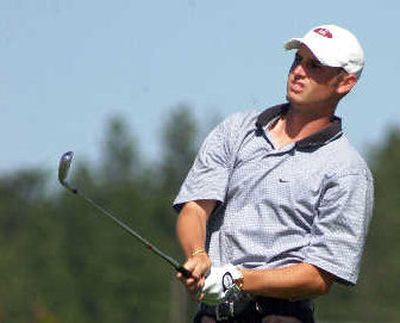Kelly retools game to take on big boys during U.S. Open

A little more than a year ago, Troy Kelly was working construction in his hometown of Tacoma – quite reluctantly, as it turns out.
“It really wasn’t where I really wanted to be at that time in my life,” admitted the 26-year-old golf professional and former member of the University of Washington golf team.
But because of his financial situation, Kelly had been forced to find a job that provided a regular paycheck. It was a way, he explained, to repay those who had helped sponsor his initial, ill-fated flirtation with the Gateway Tour in the Desert Southwest.
He put his clubs away for a little more than a year. But today, Kelly is back playing competitive golf. He won close to $35,000 – enough to cover expenses – on the Gateway Tour last summer. This week, he has himself in contention for the $5,000 first-place prize money after two rounds of the 46th annual Lilac Invitational at the Fairways at West Terrace. He plans to travel to Alaska next week to participate in another big-money tournament.
But anything that happens, either here or in Alaska, is bound to pale by comparison to Kelly’s recent experience in the United States Open Golf Championship in Pinehurst, N.C.
Kelly, after earning a spot in the event through a local qualifying tournament at the Snoqualmie Ridge TPC Golf Course, proceeded to make his U.S. Open debut a bit of a debacle by shooting an opening-round 83 on the legendary Pinehurst No. 2 course, so devilishly designed by Donald Ross.
“I jumped right into a major, right into the fire,” said Kelly, who added that the 7,214-yard Pinehurst layout was every bit as difficult as billed. The pin positions on Pinehurst’s turtle-back greens, he said, were brutal, particularly on that first day.
“They’re good-sized greens,” he explained, “but there are only certain sections you can hit your approach shot to without having it roll off the green. They’re like domes that are flat in the middle, so you’ve got to be precise with your yardage.
“Being pin-high was huge, but you could be pin-high and miss right or left by 6 feet and have your ball roll down off the green. And once it starts going, you can have it roll 20 yards down a swale and leave you pitching uphill with no chance to get close.”
To Kelly’s credit, he came back on Friday and tamed Pinehurst with a 3-under-par 67 that matched the second-lowest round of the tournament. His dramatic overnight turnaround wasn’t enough to survive the cut, but it proved to him that the talent gap between he and the world’s best golfers isn’t that large.
Kelly played his U.S. Open practice round with Sergio Garcia and later worked alongside Tiger Woods on the chipping green. He came away impressed, but only by the short-game finesse exhibited by the golfers he most wants to emulate.
“As a pro who plays primarily on the minitours, you always wonder how close you are to the guys who are actually out there on the PGA Tour,” Kelly said. “And I learned that it’s a real fine line that separates us.
“Hitting balls next to them, they weren’t really that impressive. I hit the ball just as well as those guys on the days I hit it good. But the thing that impressed me was their short games. They’re just unbelievable.”
Kelly recalled practicing his chipping next to Woods, who was slapping balls out of a sand trap.
“He hit the same shot over and over,” Kelly said. “His pattern of balls … I mean, they were surrounding the hole. But me, I’ve got one ball here, another one way over that and one I chunked short.
“And that convinced me that to get to that point and be successful on the PGA Tour, I’ve really got to improve my short game.”
After his disastrous opening round, which included 36 putts, a triple-bogey and a back-nine score of 10-over 45, Kelly came back with a sharp second round that included several splendid up-and-downs and only 26 putts.
The difference?
Not much, according to Kelly.
“I didn’t change the way I played the course that second day,” he said. “I didn’t hit any different clubs off tees or do anything that way. I just hit the ball better and made some putts. The way I look at it, I just played a bad nine holes.
“I wasn’t in a very good mood when I teed off on Friday. I wanted to suck it up and prove I can play a little bit, at least.”
Throw out the back nine on Thursday, and Kelly played his other 27 holes in even par – a fact that did not surprise his close friend and fellow Lilac Invitational competitor Conner Robbins.
“Troy has as much talent as any golfer I’ve ever played with, and I’ve played with some guys on the PGA Tour,” he said. “I was really proud of how he came back at Pinehurst.”
Kelly and Robbins, who grew up together in Kitsap, were paired in the same foursome during Friday’s second round of the Lilac. Kelly shot a 7-under 65 to climb into a tie for fifth place with a 36-hole total of 134. Robbins, following a second-round 66, is tied for second at 131.
Following Sunday’s final round, Kelly will head to Alaska. He plans to attend his first PGA qualifying school this fall.
He will undoubtedly be disappointed if he fails. But thanks to his U.S. Open experience, construction work is no longer in Kelly’s immediate future.
That 67 he shot at Pinehurst convinced him that – for the time being, at least – he is better served with a 5-iron in his hand than he is with a hammer.